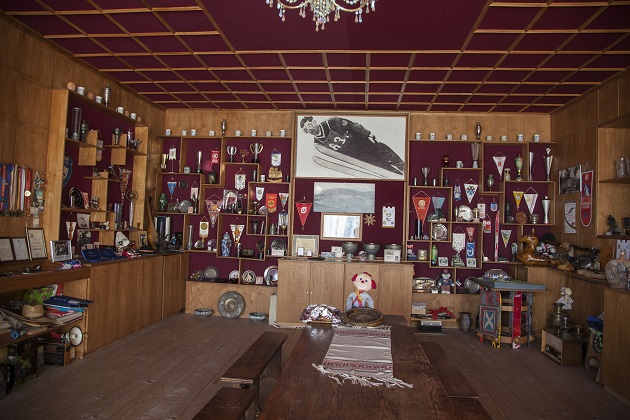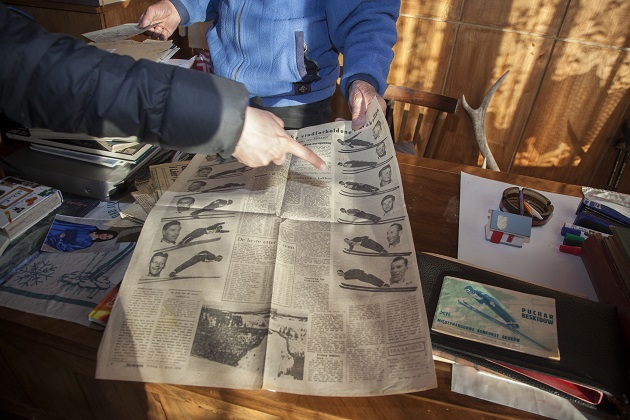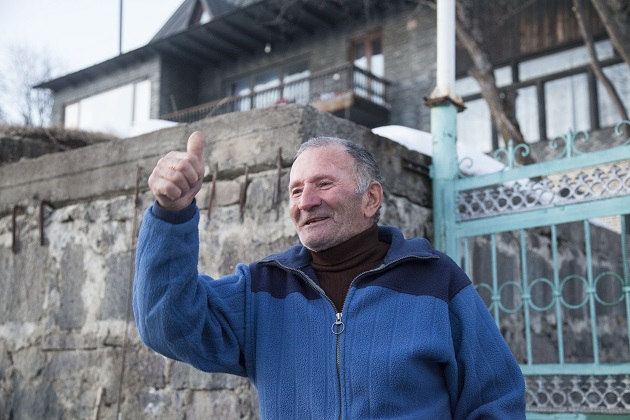Georgian legend: How the “Flying Torpedo” changed ski jumping forever


When World War II ravaged the Caucasus and almost all of the men from the Georgian village Bakuriani left to serve their country and fight on the frontline, two orphaned schoolboys were forced to leave their schooling to shepherd neighbors’ sheep.
As the war never made it to Georgian soil, the land was peaceful and eagles from the whole region flocked to the Georgian mountains and settled there.
One day while the sheep were in the pasture, one of the little shepherds looked up and observed the behavior of the birds. He noticed when an eagle was heading down to attack its prey, it flew with its head forward and wings tight alongside its body.
Several years later and the little shepherd used this technique to become one of the world’s legendary ski jumpers.

Koba Tsakadze on his first skis. Photo by N. Alavidze
Koba Tsakadze helped develop the aerodynamic compact style that is standard today in ski jumping, in which the jumper leans forward out over his skis while keeping his arms down - just like an eagle does when landing.
Nicknamed the Flying Torpedo, Tsakadze has jumped in four Winter Olympic Games – first in 1956, 1960, 1967 and finally in 1972 – and six World Championships. He is the six-time Soviet Champion who has won 54 international races.
Tsakadze, who is now aged 80, ranked 33rd on the list of world’s best ski jumpers of all time. Still healthy and strong, Tsakadze lives in his native Bakuriani, which is one of Georgia’s winter resorts and known during Soviet days as the Pearl of the Caucasus.
One of large rooms in Tsakadze’s house is fully devoted to his jumping career. Books, trophies, medals and banners cram every inch of space in the room, as a testament to the fame that being a pioneer of human flight can deliver.

Tsakadze's room devoted to his awards. Photo by N. Alavidze
At age 19, Tsakadze became a member of the Soviet Olympic team and remained as an integral member for two decades.
The sport of ski jumping originated in Norway. One of Norway's best ski jumpers, Thorleif Schjelderup, published an article in the New York Times praising teenage Tsakadze and predicting an "amazing career” for him.
"He unconsciously invented a new style. He holds his body straight and without any tension he leans over so that the distance between his face and skis is two foot. He only touches his skis with his toes. He leaps over enormously far and his jump is amazingly beautiful,” Schjelderup wrote.
"We have always believed this was exactly how one should jump but I have never thought I would ever be able to see this in real life. Tsakadze stays relaxed and maintains control during the whole process of jumping. He is extraordinarily brave, because if he hesitates, he never keeps a chance to correct a mistake.”

In his room, Tsakadze keeps everything related to his ski jumping career. Photo by N. Alavidze
Today, sitting in the room surrounded by his awards, Tsakadze is proud to remember his international fame.
It was especially memorable for him to meet German Federal Chancellor Konrad Adenauer, who held a special reception for Tsakadze in Garmish in 1961 when the young Georgian won the World Cup.
The Flying Torpedo mentioned several other famous names, which he had the honour of meeting during his sporting career and received compliments from. One of these was US Vice President Richard Nixon.
In the past Tsakadze has also attended receptions held in his honour by the King of Norway, the Yugoslav leader Josip Broz Tito, leaders of Finland, the Czech Republic, Poland and others.
While succeeding in the sporting arena, what made the legendary ski jumper most proud was a poem, written by American John Updike, which was dedicate to Tsakadze.
Beneath his nose, the ski tips shake,
Descending down the deepening wide
Bright pit of air, arms at his side,
His heart aloft for Russia’s sake.
To contradict the words in the poem, Tsakadze remained adamant he was not Russian. He may have jumped for the U.S.S.R. but he was and is a Georgian.
"They tried so hard to make me a ‘Moscowian’ but of course, they failed,” Tsakadze said.
He was offered several flats in the centre of Russian capital Moscow and brand new cars in return for competing for Russia but the Flying Torpedo refused numerous deals and returned home to his native Bakuriani time after time.

Still healthy and strong, Tsakadze, who is now aged 80, lives in his native Bakuriani, which is one of Georgia’s winter resorts and known during Soviet days as the Pearl of the Caucasus. Photo by N. Alavidze
"Seems like they were sick and tired of having a Georgian in the team for such a long time,” Tsakadze said. He claimed this was exactly why the Russians did not let him jump in the 1968 Olympics in Grenoble.
"They told me I was already too old to go to the Olympics. But the funny part is that those who spoke those words took me to the next Olympics after four years,” Tsakadze said with a satisfied smile.
His fame and success gained traction around the globe and he was offered various international invitations as well, which he also refused.
"The Americans offered me a million US dollars when Pele was only given $800 000 at that time,” Tsakadze said proudly.

The wooden box on the bottom was Tsakadze's very first suitcase when he went abroad. The other two he was given later. Photo by N. Alavidze
After all, the little orphan who began life shepherding his neighbours’ sheep and ended up as one of the world’s leading ski jumping athletes, is proud that his name will never be forgotten. For he was the one who invented a new style of ski jumping, which changed the sport forever.

Tsakadze ranked 33rd on the list of world’s best ski jumpers of all time. Photo by N. Alavidze
 Tweet
Tweet  Share
Share
